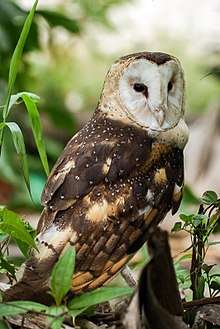Eastern grass owl
| Eastern grass owl | |
|---|---|
 | |
| Scientific classification | |
| Kingdom: | Animalia |
| Phylum: | Chordata |
| Class: | Aves |
| Order: | Strigiformes |
| Family: | Tytonidae |
| Genus: | Tyto |
| Species: | T. longimembris |
| Binomial name | |
| Tyto longimembris (Jerdon, 1839) | |
The eastern grass owl (Tyto longimembris), or Australian grass owl is a species of owl in the family Tytonidae.
Though some authorities consider this owl to be conspecific with the African grass owl, T. capensis, other consider it to be a valid species.[2]
They feed predominantly on small rodents.[3]
Description
The eastern grass owl is a medium-sized owl, similar in size to the barn owl. Adult males measure from 32 to 38 cm (13 to 15 in) in length, while the larger females can measure from 35 to 42 cm (14 to 17 in). The wingspan is from 100 to 116 cm (39 to 46 in). The female weighs 460 g (16 oz) while the male weighs 400 g (14 oz).[4][5][6] They have dark brown or tan upper parts with pale spots. They have black and tan bars on its wings and a very pale beak, feathered legs, and dark brown eyes. Like all Tyto owls, it has a heart-shaped facial disk with brown buff and a white bordering.
Call
The eastern grass owl's primary call is like many other tyto owls. A loud, hissing screech but the grass owl's screech is louder than a barn owl's but quieter than a masked owl's.
Hunting
Studies in parts of Australia have shown that the most common prey is the long-haired rat and the cane rat. Prey are detected from on the wing. The owl uses its long legs to penetrate dense ground cover and seize its prey.
Habitat
This owl prefers tall grasslands and swamps. Roost areas consist of flattened vegetation within systems of "tunnels" through the swamp vegetation. Nesting is in similar situations.
Distribution
Eastern grass owls live in eastern, southern and southeast Asia, parts of New Guinea, Australia (mainly in Queensland) and the western Pacific. It has also been found in the coastal islands.
Conservation status
Eastern grass owls are considered "least concern" globally, primarily because of their wide distribution.
Within Australia Tyto longimembris is considered vulnerable on the New South Wales Threatened Species Conservation Act (1995).
References
- ↑ BirdLife International (2012). "Tyto longimembris". IUCN Red List of Threatened Species. Version 2013.2. International Union for Conservation of Nature. Retrieved 26 November 2013.
- ↑ Christidis, Les; Boles, Walter (2008). Systematics and Taxonomy of Australian Birds. Collingwood, Victoria: CSIRO Publishing. p. 168. ISBN 0-643-06511-3.
- ↑ Wen-Loung Lin, Yin Wang and Hui-Yun Tseng (2007) Initial Investigation on the Diet of Eastern Grass Owl (Tyto longimembris) in Southern Taiwan. Taiwania, 52(1): 100-105
- ↑
- ↑ Ali, Sálim (1996). The Book of Indian Birds (12th ed.). Bombay: Bombay Natural History Society. ISBN 0-19-563731-3.
- ↑
External links
| Wikimedia Commons has media related to Tyto longimembris. |
| Wikispecies has information related to Tyto longimembris |
